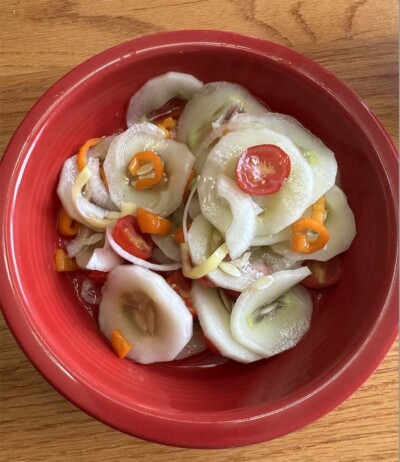This Week In Ag #128
“We’re serving depression food.” That’s how I describe the summer delicacy my wife prepares for social gatherings we host and attend. It’s a creation of cucumbers, peppers, onions and tomatoes – all grown from my garden – soaked in vinegar and sugar. A dish passed down by my grandmother, born out of necessity more so than culinary delight: simple, flavorful vegetables grown and then preserved.

Depression food
Most people automatically assume that my love of farming stems from my paternal side of multi-generational farmers. And they certainly played a big role. But much of my passion for agriculture comes from my Grandpa Vancil. He grew a massive garden. But he didn’t start doing it as a hobby, he did it to survive. The same reason he would fish and hunt. He taught me all those life skills and the patience required to perform them.
You see, Grandpa Vancil lived during the Great Depression. Much of his childhood was spent working in Civilian Conservations Corps work camps set up by the government.
Food was incredibly scarce. So he and his family were forced to grow or catch their own. What they didn’t eat fresh, they preserved by a variety of means.
My grandma canned much of the food they grew. In fact, growing up, I rarely saw store bought canned vegetables at her house. They consumed her canned produce until next year’s garden yielded fresh. And their freezer was also full of fish they caught.
To me, Grandpa and Grandma Vancil will always epitomize “The Greatest Generation”. They endured The Great Depression, he served in WWII as she prayed for his return while working as a real-life Rosie the Riveter. Upon his return from Europe, they raised a family and he got a job working on the railroad. Hard labor to say the least in those days, but he never complained.
Through hard work and longevity their financial situation, like many of their fellow Americans, changed from the dark days of the depression. But their way of life did not. Grandpa continued to plant a massive garden every year of his life. And much of what was not eaten fresh was canned.
Each year, I look forward to picking our own vegetables and making “depression food.” I savor every bite. For me, it’s more than a matter of taste. It’s a tribute to my heroes.
Related Posts

Microorganisms: The Living Engine of Soil—Part 2
In Part 2 of this series, we look at Plant-Microbial Interactions.

This Week in Ag #48
The popular TV series Yellowstone, along with the western lifestyle craze, has certainly romanticized ranching. It seems like everyone wants to be a rancher, until there’s real-world ranching stuff to do. This week’s bone-chilling Midwestern weather brings back memories. Notice I didn’t say fond memories. When you have livestock, they require care every day. Utility tractors

BHN’s Dr. Abi-Ghanem Selected to Speak at Soil Society Leadership Panel
Dr. Rita Abi-Ghanem, Senior Director of Research & Development at Bio Huma Netics, Inc., has been selected to speak as part of a Soil Science Society of America (SSSA) panel discussion on Leadership at the 2019 International Soils Meeting, “Soils Across Latitudes, on January 8, 2019, in San Diego, California. Dr. Abi-Ghanem will be representing

